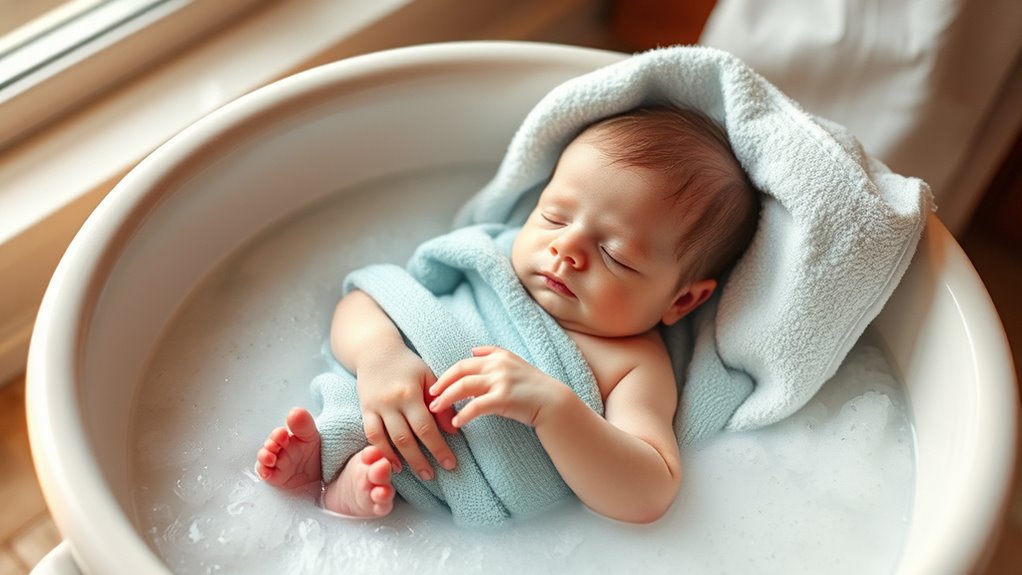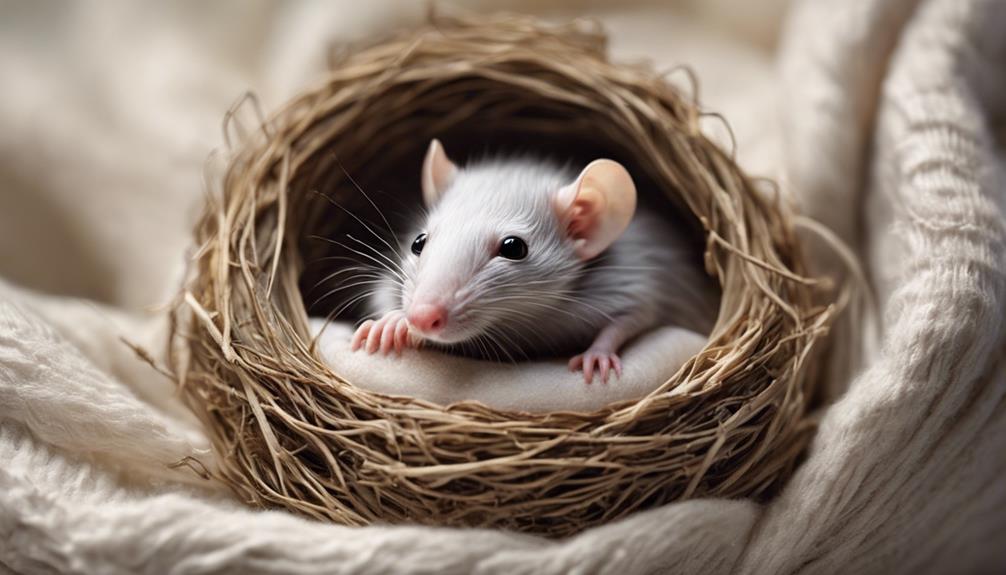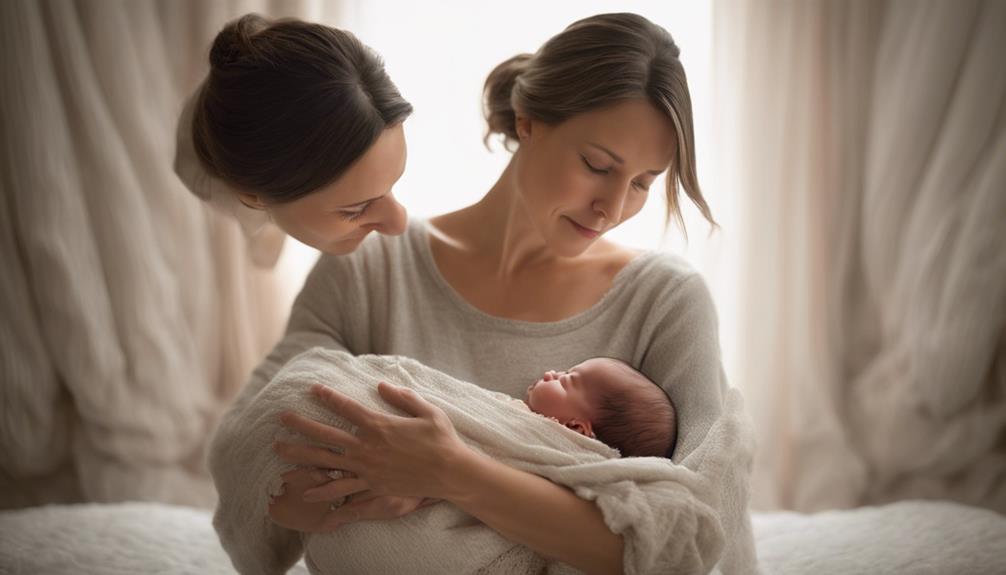You should bathe your newborn 2 to 3 times a week to keep their skin healthy without causing dryness. Use warm water, gentle soap, and keep the environment calm and cozy. Make sure all supplies are within reach before starting, and support your baby’s head and neck during the process. To learn step-by-step tips and how to keep your baby comfortable and safe, continue exploring this helpful guide.
Key Takeaways
- Bathe your newborn 2-3 times weekly; daily baths are unnecessary and may dry skin.
- Prepare all supplies, check water temperature (around 100°F), and ensure a warm, safe environment before starting.
- Use gentle, tear-free cleansers, soft washcloths, and support the baby’s head and neck securely during washing.
- Pat dry, apply hypoallergenic lotion, and incorporate calming techniques like gentle massage post-bath.
- Consult a pediatrician if persistent skin issues, discomfort, or signs of infection occur.
How Often Should You Bathe a Newborn?
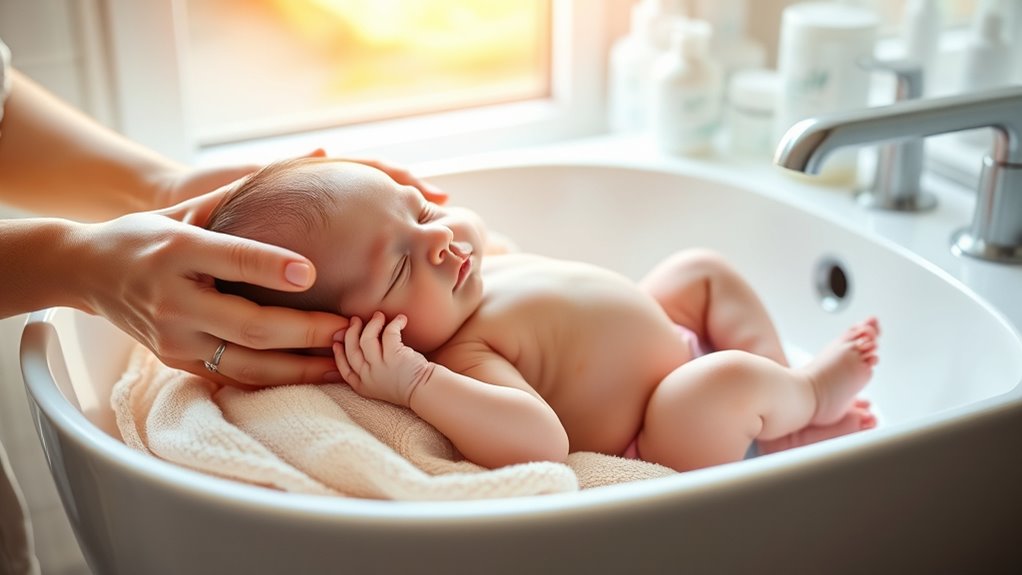
You don’t need to bathe your newborn every day, as their skin is delicate and can dry out easily. Typically, a bath two to three times a week is enough to keep your baby clean without causing irritation. Between baths, you should focus on regular diaper changes to prevent diaper rash and keep your baby comfortable. When it’s time for a bath, make sure the bath temperature is warm but not hot—around 100°F (38°C)—to keep your baby safe and comfortable. Use a thermometer to check the water temperature, and always test it with your wrist or elbow before placing your baby in. This approach helps you maintain a safe, soothing routine that keeps your newborn clean without overdoing it. Additionally, understanding your baby’s skin sensitivity can help you choose gentle skincare products and bathing routines. Practicing safe bathing practices ensures your baby remains comfortable and reduces the risk of accidents. Choosing the right bathing frequency ensures your baby’s delicate skin remains healthy and irritation-free.
Signs Your Baby Needs a Bath
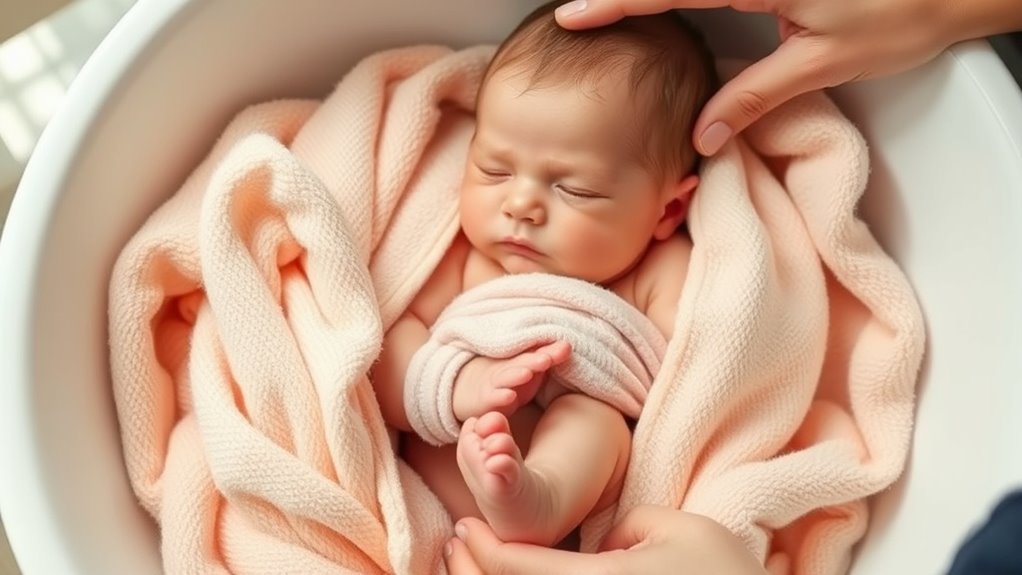
Knowing when your baby needs a bath can help you maintain their comfort and hygiene. Look for signs like lingering odors after diaper changes or if your baby’s skin feels sticky or visibly dirty. If your baby seems fussy during diaper changes, it might be time for a bath. Also, if they’ve had a lot of baby massage and sweat or dirt has accumulated, a bath can help refresh them. Here’s a quick guide:
| Sign | What to Do | When to Act |
|---|---|---|
| Sticky or dirty skin | Give a gentle bath | After diaper changes or dirt buildup |
| Unpleasant odor | Bathe your baby | Daily or as needed |
| Fussiness during diaper | Consider a bath to refresh | When signs persist |
| Excessive sweating or dirt | Schedule a bath | After activities or massage |
These signs ensure your baby stays fresh and comfortable. Regular bathing also supports your baby’s skin health by removing irritants and preventing rashes. Incorporating bathing routines into daily care can also help establish a sense of security and comfort for your baby.
Preparing for Bath Time: What You Need
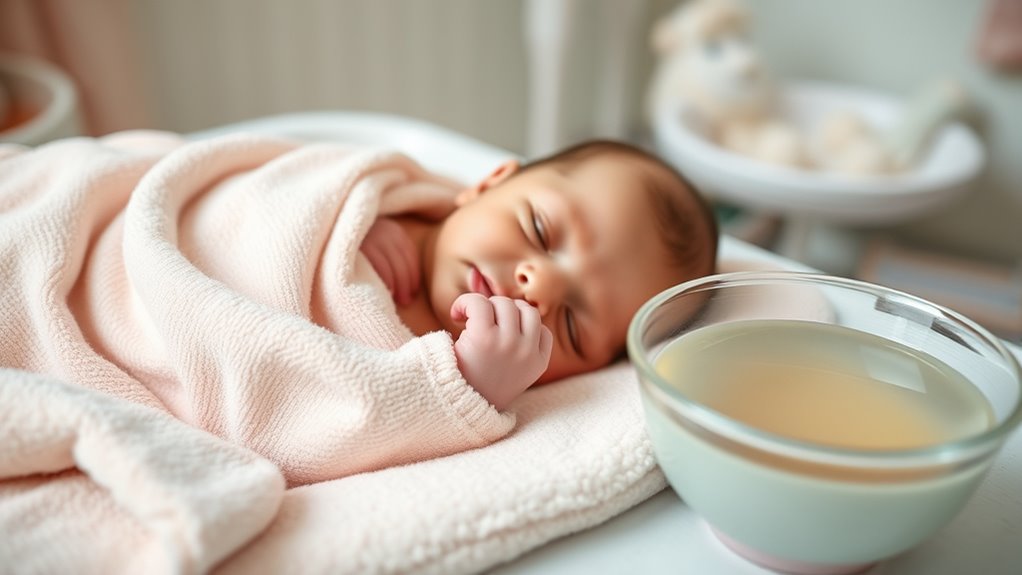
Getting ready for bath time involves gathering all the supplies you’ll need beforehand, so everything is within reach and the process goes smoothly. Start with soft baby washcloths, which are gentle on your newborn’s sensitive skin. Have a clean towel nearby for drying and a gentle baby soap or cleanser ready if needed. Check the water temperature first—make sure it’s warm, around 100°F (38°C), to keep your baby comfortable and prevent burns. Use your wrist or elbow to test the water, ensuring it’s not too hot or cold. Having everything prepared in advance helps keep your baby safe and calm during the bath, making the experience more pleasant for both of you. Monitoring water temperature accuracy is also crucial to ensure safety and comfort during bath time. Additionally, ensuring proper bathroom safety measures can prevent accidents and make the process smoother. Being aware of keto diet tracking methods can help you maintain your health goals in a structured way.
Step-by-Step Guide to Bathing Your Newborn
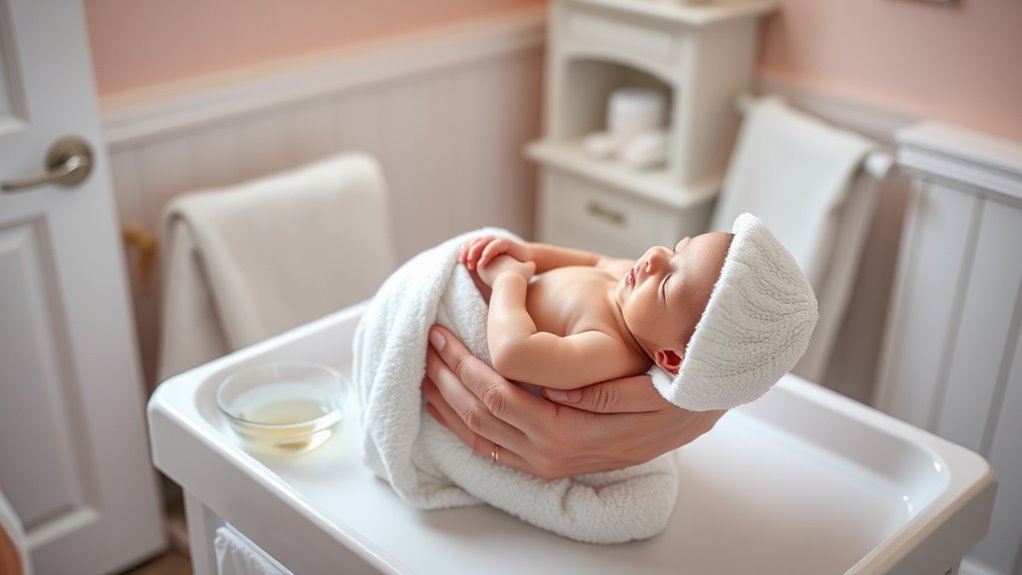
Before you start, set up a safe, warm bathing area to keep your baby comfortable. Use gentle washing techniques, like soft strokes and mild soap, to safeguard your newborn’s delicate skin. You can also consider newborn skin sensitivity when choosing bath products to prevent irritation. Proper water temperature is crucial, and using a self watering plant pot analogy can help you understand how to maintain consistent moisture levels during bathing to keep your baby comfortable. Following these steps helps ensure a calm and safe bath for your little one. Additionally, keeping the bathroom environment free of hazards and at a comfortable temperature can further promote a soothing experience.
Preparing Bathing Area
To guarantee a safe and comfortable bathing experience for your newborn, start by preparing a clean, warm, and clutter-free bathing area. Ensure good bathroom ventilation to prevent humidity buildup, which can make the space uncomfortable. Choose a spot with a flat surface and easy access to water and towels. Check the water temperature with your wrist or elbow, making sure it’s warm but not hot—around 100°F (37.8°C). Keep all bathing supplies within reach so you won’t have to leave your baby unattended. Clear away any objects that could pose a hazard or cause clutter. Proper preparation helps your baby feel secure and makes the process smoother for you. Additionally, maintaining a calm atmosphere can help soothe your newborn during bath time. Creating a positive environment can also help build a comforting routine for both you and your baby.
Gentle Washing Techniques
Gently washing your newborn sets the foundation for a comfortable and safe bath. Use gentle washing techniques to avoid irritating their sensitive skin. Begin by wetting a soft washcloth with warm water, then carefully wipe your baby’s face, avoiding the eyes. When cleaning the body, use a mild, fragrance-free cleanser and delicate scrubbing, focusing on folds and creases where dirt can hide. Be gentle—avoid scrubbing too hard, as rough movements can cause discomfort or skin irritation. Rinse thoroughly with clean water, ensuring no soap residue remains. Throughout the process, support your baby’s head and neck securely. This careful, delicate scrubbing helps keep your newborn clean while maintaining their comfort and safety during bath time. Additionally, understanding skin sensitivity can help you choose appropriate bathing products and techniques. Incorporating gentle washing techniques not only protects delicate skin but also promotes a calming and enjoyable bath experience for your baby. Being aware of best practices for bathing can further enhance your baby’s safety and comfort during bath time.
Tips for a Safe and Comfortable Bath Experience
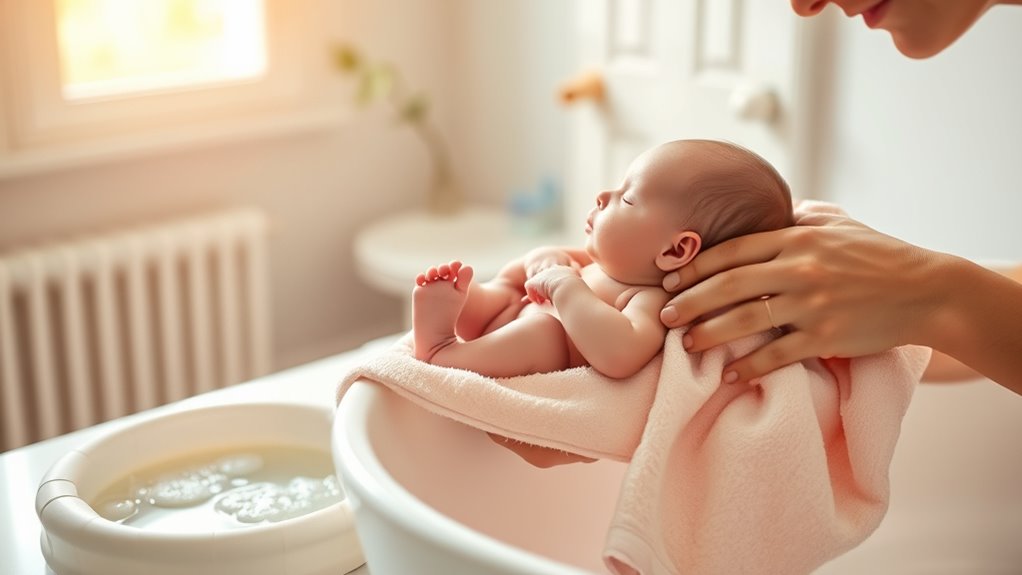
Ensuring your newborn’s bath is both safe and comfortable starts with careful preparation. Gather all supplies beforehand, including a soft washcloth, mild baby soap, and a clean towel. Support your baby’s head and neck, especially when washing their baby hair, to prevent slipping. Keep the water warm but not hot—around 100°F (37.8°C)—to avoid discomfort or burns. Be gentle around areas prone to diaper rash, ensuring they stay dry and clean, which helps prevent irritation. Never leave your baby unattended, even for a moment. Talk softly and maintain eye contact to help your little one feel secure. Staying calm and attentive makes the experience soothing and safe, turning bath time into a comforting routine. Additionally, understanding Ford Tuning principles can inspire creative ways to personalize your baby’s bath experience through safe and gentle modifications to your routine. Remember that gentle essential oils can also enhance the calming atmosphere if used appropriately and in moderation. Incorporating pinball machines or themed decor into the nursery can create a playful and engaging environment that stimulates your baby’s senses.
Choosing the Right Products for Your Baby’s Skin

Choosing the right products for your baby’s skin is essential to keep it healthy and comfortable. Opt for a gentle, tear-free baby shampoo that won’t irritate sensitive skin or eyes. Look for products free of harsh chemicals, dyes, and fragrances. When selecting bath toys, choose ones that are safe, non-toxic, and easy to clean, preventing mold or bacteria buildup. Avoid overly scented or medicated products unless recommended by your pediatrician. Always check labels for hypoallergenic options designed specifically for newborns. Using gentle, appropriate products helps maintain your baby’s natural skin barrier and prevents dryness or irritation. Remember, simple is best—clean, mild, and safe products support your newborn’s delicate skin during bath time.
How to Keep Baby Calm During Bath Time

To keep your baby calm during bath time, use gentle handling techniques that make them feel secure and comforted. Create a soothing bath environment by dimming the lights and playing soft music to relax both of you. These simple steps help your little one stay calm and enjoy the experience. Using a comfortable design for your baby’s bath accessories can also enhance their sense of security and ease during the process.
Gentle Handling Techniques
Keeping your baby calm during bath time starts with gentle handling. Babies have sensitive skin and respond well to calm, soothing touch. To guarantee a relaxed experience, follow these tips:
- Support your baby’s head and neck securely and gently, keeping movements slow and steady.
- Use soft, gentle strokes to handle your baby’s skin, respecting their skin sensitivity.
- Speak softly and maintain eye contact to create a reassuring environment.
- Keep the bath water at a comfortable, warm temperature to avoid startling or discomforting your baby.
Soothing Bath Environment
Creating a calm and soothing bath environment helps your baby feel safe and relaxed. Use gentle lighting, soft towels, and a warm room to set a peaceful scene. Incorporate calming ambient sounds, like lullabies or white noise, to further comfort your baby. This helps reduce fussiness and creates a positive experience. Consider the following tips:
| Tip | Benefit |
|---|---|
| Dim the lights | Less stimulation, calmer baby |
| Play calming sounds | Soothes nerves, promotes relaxation |
| Use a warm, cozy towel | Keeps baby comfortable and secure |
After-Bath Care and Skin Moisturizing

After bathing your newborn, gently pat their skin dry with a soft towel, making sure to leave some moisture on the skin. This helps lock in hydration and keeps their skin soft. Next, consider these steps for ideal after-bath care and skin moisturizing:
- Use a gentle, fragrance-free lotion to soothe skin sensitivities and prevent dryness.
- Incorporate a calming baby massage to promote relaxation and improve circulation.
- Pay special attention to skin folds, drying them thoroughly to prevent irritation.
- Choose hypoallergenic products designed for delicate skin to reduce the risk of reactions.
When to Consult a Pediatrician About Bathing Concerns

While most newborns tolerate baths well, certain signs indicate you should consult a pediatrician promptly. If your baby shows persistent skin irritation, unusual rashes, or if bathing seems to cause discomfort or crying that doesn’t improve, it’s time to seek professional advice. Also, if your newborn develops any signs of infection, such as swelling, pus, or fever, don’t hesitate to schedule a pediatrician consultation. Concerns about dry skin, eczema, or skin peeling that worsens after bathing are important to address with a healthcare provider. Remember, your pediatrician can help identify underlying issues and recommend gentle skincare routines. Trust your instincts—if something feels off or your bathing concerns persist, consulting a pediatrician ensures your baby’s comfort and health.
Frequently Asked Questions
Can I Use Regular Soap on My Newborn?
You shouldn’t use regular soap on your newborn because it can be too harsh for their delicate skin. Instead, opt for gentle cleansers specifically made for babies. These products clean without stripping moisture and reduce irritation. After the bath, apply moisturizing lotions designed for newborns to keep their skin soft and hydrated. Always check labels and consult your pediatrician if you’re unsure about which products are safe for your little one.
How Do I Handle a Newborn Who Hates Baths?
If your newborn hates baths, try gentle handling and calming techniques to make the experience more comfortable. Use a soft voice, gentle splashes, and keep the bath brief. You can also try sponge baths instead of full immersions at first. Keep the environment warm and soothing, and distract them with toys or singing. Over time, these calming methods help your baby feel safe and may reduce their bath resistance.
What Temperature Should the Bathwater Be?
Warm water works wonders for your newborn’s bath. Aim for a bathwater temperature between 90 and 100 degrees Fahrenheit, ensuring it’s just right—not too hot or cold. Always test the water with your wrist or elbow before bathing to follow safe bathing practices. By maintaining this perfect temperature, you create a comfortable, calming experience for your baby, making bath time safe, soothing, and stress-free.
How Often Should the Umbilical Cord Area Be Washed?
You should clean the umbilical cord area daily, using gentle hygiene practices. Gently wipe around the cord with a clean, damp cloth, making sure to keep it dry afterward. Avoid submerging the cord in water until it falls off naturally. Proper hygiene helps prevent infections and promotes healing. Remember, being consistent with cleaning and keeping the area dry are key to maintaining good hygiene practices for your newborn.
Are There Any Signs of Skin Irritation to Watch For?
Watch carefully for signs of skin irritation like redness, rash, or dryness, which could signal a problem. If your baby’s skin shows persistent dryness, inflammation, or develops a rash that doesn’t fade, it’s time to act. These signs can indicate irritation or an allergy, so keep an eye out for them daily. Prompt attention helps prevent discomfort and promotes healthy skin, ensuring your little one stays happy and safe.
Conclusion
Think of bathing your newborn as tending a delicate garden—you nurture and protect each tiny blossom with gentle care. With patience and attention, you’ll help this new life blossom beautifully, building trust and comfort along the way. Remember, each bath is a small, essential step in their growth—a moment of connection that lays the foundation for a lifetime of well-being. With love and consistency, you’ll cultivate a healthy, happy start for your little one.
